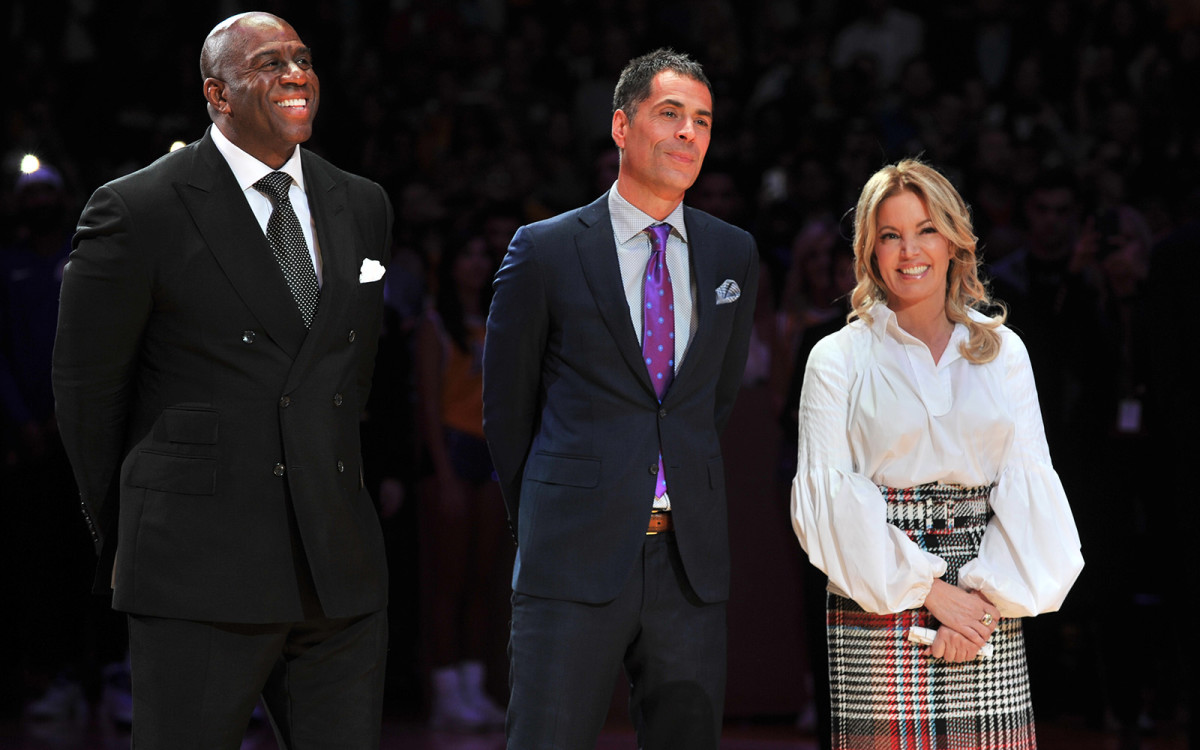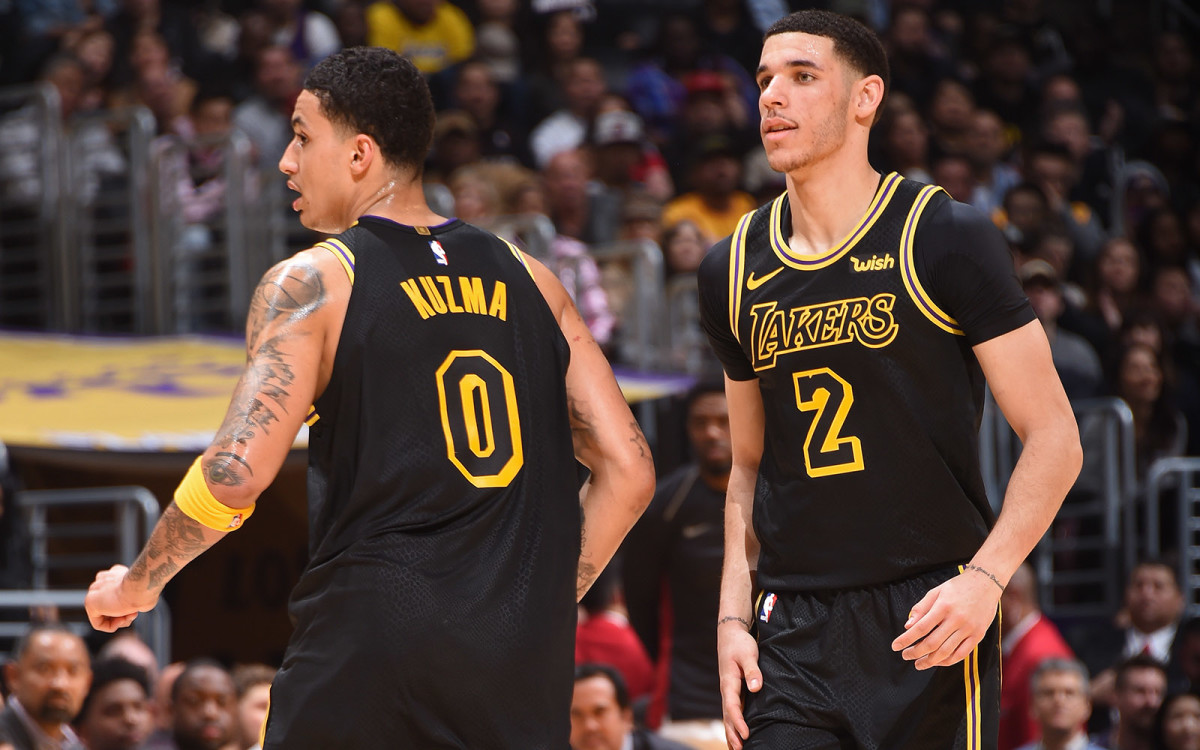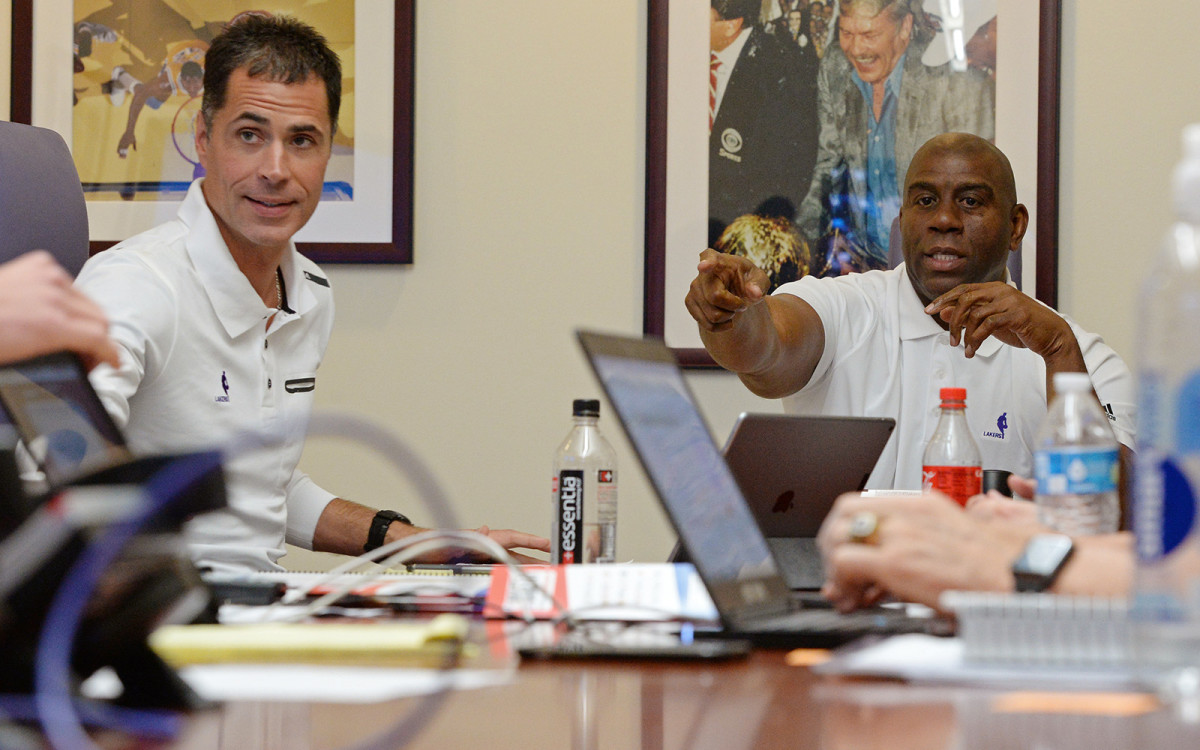Summer of Showtime: Why All Eyes Will Be on the Lakers

On the first day of the last week of the Lakers rebuild, the ground shook beneath their new home. General manager Rob Pelinka was sitting on a narrow balcony outside his second-floor office, overlooking two empty practice courts at the nine-month-old training facility, when the baskets swayed and the floodlights trembled. The team of the summer, and the specter over the offseason, was briefly rattled. “Maybe we should walk off this ledge,” Pelinka said, leaving beneath his chair the program for the 1988 Schlitz Malt Liquor Summer Basketball League.
At the time of the 5.3 magnitude earthquake, centered about 75 miles west of the Lakers’ headquarters in El Segundo, Calif., Pelinka was flipping through the yellowed pages of that program, his first guide to transcendent talent. He grew up on Chicago’s North Shore, his father a longtime teacher and coach at Lake Forest High. Pelinka was a John Hughes character come to life, the charismatic suburban basketball star. On weekends, his dad drove him to the South Side so he could taste real competition. After graduating from Lake Forest in ’88, he earned a coveted spot in the Schlitz League.
Pelinka and Maurice Cheeks formed the backcourt for Luster Premium Hair Products. Mark Aguirre and Kendall Gill played for Seville Motel, Tim Hardaway and Nick Anderson for First Chicago Bank, Ken Norman for Johnnie Walker Red, Kevin Duckworth for Seduction By Rodney. But they were all fodder for the powerhouse from Playboy, fronted by Michael Jordan, Doc Rivers and Terry Cummings. This was a different era, when the best player in the world could spend the summer matched up against an 18-year-old, malt liquor plugged on the front of his jersey and a girlie mag on the back.
Doubleheaders unfolded every Sunday and Monday night from mid-July to mid-August at Illinois Institute of Technology. Admission was free. Once, a gunman strode onto the floor, and Pelinka was so stunned by the ringing shots he forgot to hit the deck. A teammate had to tackle him. He signed with Michigan and immediately won a national championship alongside Glen Rice and Rumeal Robinson. Two years later, the Fab Five arrived in Ann Arbor, and a couple more Final Fours followed. Pelinka was a deadeye shooter and a reliable reserve, a good player defined by his uncanny proximity to elite players.
He became an agent in 1996, and within two years he was representing Kobe Bryant, fielding phone calls that started like this: “I’m watching how cheetahs attack wildebeests. Cheetahs are obviously the fastest animals, but when they jump, they use their tail as a lever for balance. When I work on my fadeaway, I’m going to manipulate my foot depending on where the defenders are, so I can change my balance in the air like a cheetah.” Pelinka later inked James Harden, and for a short time Kevin Durant, gaining more access to the minds of megastars.
The Lakers hired Magic Johnson as president of basketball operations in February 2017 and Pelinka as GM the following month, affixing him to yet another icon. “I need somebody who understands agents and trades and the collective bargaining agreement,” owner Jeanie Buss told Pelinka and Bryant over lunch at Pelican Hill, shortly after tabbing Johnson. “Somebody like . . . you.”
The Lakers were mired in their fourth straight miserable season. NBA reconstruction is always agonizing, even for a franchise with 16 titles, but L.A. prolonged the pain with Bryant’s two-year farewell tour. Few free agents yearned to be his apprentice or heir, so the Lakers handed $72 million to Luol Deng and $64 million to Timofey Mozgov, ludicrous contracts in the cap-spiked summer of ’16. They employed a dynamic young coach, Luke Walton, and drafted Brandon Ingram and Julius Randle early, Jordan Clarkson and Larry Nance Jr. late. Those were good choices. Putting Nick Young in a leader-ship role was not.

Because Bryant developed a relationship with Jerry Buss, so did Pelinka, and the three power brokers used to meet at the owner’s home in Playa del Rey. But Buss died in 2013, leaving Pelinka to wonder what the Lakers patriarch would make of their current state. “I think there became a comfort in the banners,” Pelinka concluded. “No one saw the progress, the pioneering of new things, which is what we used to be known for. No one was saying, ‘We want to do what the Lakers are doing.’ It was the opposite. It was, ‘No one wants to go there anymore.’ ” He typed a five-page document under the heading “Pillars of Excellence,” blending Buss’s principles with his own.
Move early: The Lakers were not the only organization to spend recklessly after the spike, but they were among the first to undo a mistake. They dumped Mozgov on the Nets two days before the 2017 draft, attaching point guard D’Angelo Russell as the chaser.
History swerves: In an age of score-first point guards, Lonzo Ball represented a pass-happy alternative. L.A. drafted him second, betting he could transform the team simply by sharing the ball.
Play with pace: During Pelinka’s hourlong commute in his self-driving Tesla, he watched college clips on Synergy Sports, captivated by a fluid and fearless wing who seemed to carry an extra 20 pounds from the Utah cafeteria. The Lakers spent the 27th pick, acquired from Brooklyn in the Mozgov deal, on Kyle Kuzma.
Pelinka’s father, Robert Sr., did not see the draft. He died in April of colon cancer, and a few months later, his mom sent the program from the Schlitz League. Jordan’s name is starred and highlighted on one page, Pelinka’s on the next, a reminder that he has never been far from the phenoms. Who knows if Ball turns out to be Jason Kidd or Ricky Rubio, if Ingram plays like Durant or just looks like him, if Randle is a state-of-the-art center or a discontinued forward. Ball and Ingram are 20, Kuzma 22, Randle 23, old enough only to inspire hope and test faith. Maybe they compose the core of a future champion or the lure for a glittery free agent. Maybe they’re trade bait for a disgruntled headliner. Maybe they’re all of those things. Maybe they’re none.
2018 NBA Draft Big Board 6.0: Top 80 Prospects As We Enter the Predraft Process
The Lakers lost 47 games this season and missed the playoffs again, yet because of their intriguing prospects and two maximum salary slots, you may hear more about them in the next three months than the Warriors and Rockets combined. After a half-decade of hand-wringing, L.A. is stepping back from the ledge, bracing for an earth-shattering summer.
On the second day of the last week of the Lakers rebuild, the immortals gathered on a makeshift stage outside Staples Center to toast the unveiling of Elgin Baylor’s statue. Magic greeted Coop and Silk and Cap by nickname. Jerry West teared up. Shaq cracked Viagra jokes. Kobe beamed in via video. Bill Russell played the villain. All was as it should be. Nobody does jersey retirements and statue unveilings like the Lakers, partly because they have the most practice, and also because they get the best guests.
Since the Lakers moved from Minneapolis to L.A. in 1960—Baylor stood in the back of a pickup truck and used a megaphone to beg fans to buy tickets—five men have been the face of the franchise. They were acquired in different ways. Johnson and West were drafted. Bryant and Abdul-Jabbar came through trades. O’Neal was the lone free agent. When he signed in 1996, the Lakers had just been dispatched by the Rockets in the first round of the playoffs. The roster was uninspiring except for a pair of promising 24-year-old guards, Nick Van Exel and Eddie Jones. O’Neal placed a massive bet on those two and on West, the GM who was touting the addition of a precocious high schooler from Philadelphia.
Of course, Bryant eventually eclipsed Van Exel, but Nick the Quick retains a special place in Lakers lore. So when Kuzma strolled into Staples on April 4 rocking a Champion-issued purple number 9, purchased at a vintage shop on Melrose, O’Neal beamed and LeBron James tweeted eight fire emojis. “Our record doesn’t show it,” Kuzma said, “but I feel like the whole league is watching us.” The eyes that matter most belong to James and Paul George, free-agents-to-be who adore L.A. but would not consider joining a team bereft of talent.
How Damian Lillard Redefined the Meaning of 'Dame Time'
Kuzma, Ingram and Randle all averaged 16.1 points this season. The defense, ranked 30th in the NBA each of the past two years, was 12th. Ball’s jump shot was ragged, but his rookie numbers were almost identical to Kidd’s, and the Lakers operated even faster than the Warriors. “When you’re out there with Zo, you get the reason for the hype,” Kuzma says. “He’s not going to wow you with scoring. But if you’re a true basketball fan, you appreciate the beauty of what he does. He gets a rebound, you run ahead, and he throws it like 60 feet without dribbling.”
During a nine-game midwinter losing streak, when Ball’s shot was clanking and his father was chirping, he and Kuzma talked about Oklahoma City. “Remember when KD and Russ were young, and they were 3–29,” Kuzma said of Durant and Westbrook. “This happens.” The Lakers are the rare club following the OKC model and the Miami model at the same time, developing their nucleus while dangling their cap space. “That’s the beauty of it,” Pelinka says. “Whatever the road becomes—Is it two max guys this summer? Is it one this summer and one the next? Is it splitting up the space and just growing this young core?—it’s a good road to be on.”
Los Angeles is both an incubator and a showcase, grooming Kuzma & Co. to be stars while recognizing they may wind up as sidekicks. “The only thing we know for sure is we’re going to be here and become the Lakers again,” Kuzma says. “If they bring somebody else, that’s great. But you always want to say you did something on your own.” He did not wear the throwback jersey for symbolic reasons, and as he peeled it off in the locker room, he was actually channeling Van Exel’s substitute.

Earlier this season, Bryant took Kuzma to dinner at BOA Steakhouse in West Hollywood and told him, “It’s not what you do in the national TV games. It’s what you do on a back-to-back in Minnesota when you’re tired but you’re still trying to dominate, to kill.” Kuzma was at home against the Spurs on April 4, with ESPN broadcasting, but he’d played 36 minutes the night before in Utah and his legs were cooked. “I get through a lot of situations,” Kuzma says, “asking myself what Kobe would do.” He logged another 43 minutes on two bum ankles, scored 30 points and beat San Antonio in overtime.
“We’re ready to start winning,” Walton says, after two years of learning through losing. “There were times it got to me, dark and sleepless nights, when the trail was foggy. I questioned myself: Are we doing the right things?” He would bench Randle, then watch the video and wonder if he was too harsh, prompting a late-night call. Most Lakers have a story about Walton upbraiding them on the court and circling back soon after. “Don’t just work with these guys,” he tells his assistants. “Find out who they are.” Walton connects with Ball on several levels. Both are So Cal natives and Pac-12 legends who played for the Lakers. More important, both grew up in the shadow of outsized fathers, though Bill never lobbied for the firing of Phil Jackson from Lithuania. “Every human is on the same journey of self-discovery,” Walton says. “When you have a larger-than-life dad, it can take more time, more commitment.” At 20, he was still searching for his voice, but by 30, the Zen Master knew he’d be a coach.
Before this season, Walton spent three days at Seahawks training camp. He sat in on meetings with Pete Carroll and stood behind huddles. “You walk in a room, the music is turned up so high you have to yell,” Walton says. “Their culture is loud and chaotic and beautiful.” But it’s not necessarily him. Walton’s charm is his chill. He is still the rookie Karl Malone paid $25,000 to haze, as retribution for a comment Bill made on TV, only to lose his nerve when he actually met Bill’s disarming son. “You have to stay true to yourself,” Carroll told Walton, “and flood that into the group.”
So Walton stops a film session and asks Kuzma to take over. Walk us through this clip? Where should Lonzo be? Where should Brandon be? He calls a timeout and asks Randle for input on the defense. Do you want to ice the screen or switch everything 1–4? He has convinced players to take ownership of a team they may never own.
The Lakers’ roster is filled with recent draft picks and veterans on short-term deals, a formula for NBA disaster, as journeymen chase shots and rookies hit walls. Sixty losses would have spooked James and George. But Walton steered the Lakers to respectability, and given their many other resources, that might be far enough.

The closer is ready, waiting in the wood-paneled Terrace Dining Room at Riviera Country Club in Pacific Palisades, before the Lakers annual charity golf tournament. July 1 is still 10 weeks away, but Magic sounds as if he has been practicing his pitch. “You tailor your message to the individual,” Johnson starts. “You have to know what’s important to them and how we can help them achieve their goals, on and off the court, but especially on. You also have to tell them how special this is and what it means. Face of the Lakers, nothing competes with that. You’re great here, you win here, it’s forever. It’s magical. It brings you so many things you can’t even see or imagine. Here I am, almost 60, and I’m still the prince of the city.” He howls, but he is not joking.
Letting Johnson run point for free-agent presentations seems a little unfair. When Kuzma interviewed with the Lakers at the combine in Chicago last May, he was sweating through his dress shirt. “I mean, it’s Magic Johnson, but then he smiles, so you smile and the whole vibe changes,” Kuzma recalls. “This isn’t some analytics guy with glasses talking about your per-48. It’s laid-back, feet up, chilling and talking.” Kuzma is from Flint, Mich., 55 miles from Johnson’s hometown of Lansing. He launched into his life story, sharing that he and his mother were once homeless. The Lakers, desperate for an infusion of edge, were smitten.
Johnson talks to Pelinka every day at 5 a.m., when he is driving to Equinox Fitness Club for a workout with Byron Scott, and the GM is driving to El Moro Trail for a six-mile run. Before the trading deadline in February, Johnson wanted to clear cap space for a second max contract and replenish a first-round draft pick while remaining competitive. The Lakers accomplished all three objectives, sending Clarkson and Nance to Cleveland for Isaiah Thomas, Channing Frye and the pick.
Johnson’s first year in charge was not without challenge. He became versed in tampering rules (after the Lakers incurred two fines totaling $550,000) and Big Ballers (falling silent after LaVar’s critiques from the Baltics). Johnson gave Lonzo space, jotting notes to share in the summer, away from the reality-show cameras: “He needs that little floater. . . . He’s got to be able to finish drives. He looks to pass and defenses know that. . . . He has to be on balance with his jumper. When his feet are close together, and he’s off balance, he misses every time.”

Despite a couple public airballs, the season was a success. “We had to show that we have really good young players, and we did that,” Johnson says. “That’s what guys and their agents want to see: ‘If I put my talent with your talent, can we win?’ I think we proved you can.” Beyond the Oklahoma City and Miami models, Johnson admires another blueprint, in Boston. “Kyrie Irving got with young, talented players,” Johnson says. “It’s not that you have to have a Big Three anymore. You have to have young horses to go with a superstar or two.” If the Lakers land one, they could re-sign Randle, a restricted free agent. If they nab two, Randle is probably gone.
“They’ll get somebody soon,” says an All-Star due to hit free agency in the near future. “They play hard. They play together. They know their role. And, most important, they’re in Los Angeles.” For years the Lakers sold their town and their tradition, and it was not enough. But the rejections of Dwight Howard and Carmelo Anthony, Greg Monroe and LaMarcus Aldridge, boosted them as much as any acquisition. They were forced to trust a shrewd scouting department, led by Jesse Buss, and rebuild the same way as their peers, with a pile of picks. Now the sunshine might matter.
Johnson ducks out of the Riviera clubhouse in his black Lakers polo and hops into a golf cart, headed for a hundred fairway photo ops. “Come on, let’s get pictures!” he hollers. “We want foursomes—two on this side, two on that side.” He hugs strangers. He promises playoffs. Then, as the celebrities and philanthropists ride toward the first tee, he rushes back to the clubhouse. His car is waiting. The rebuild is ending. July beckons.
“I can’t wait,” the closer says.
